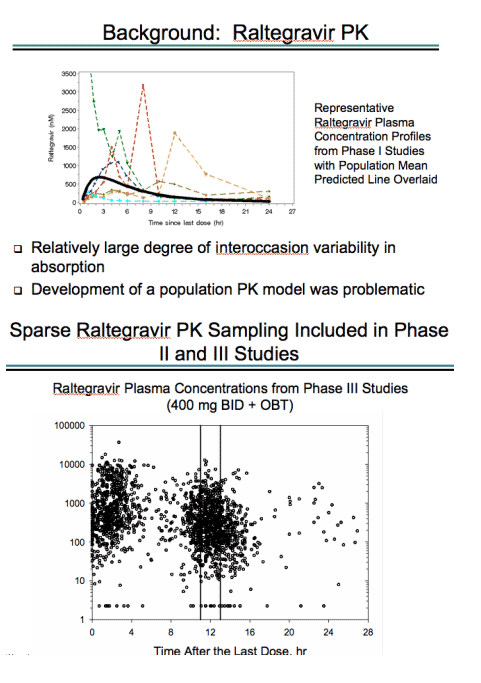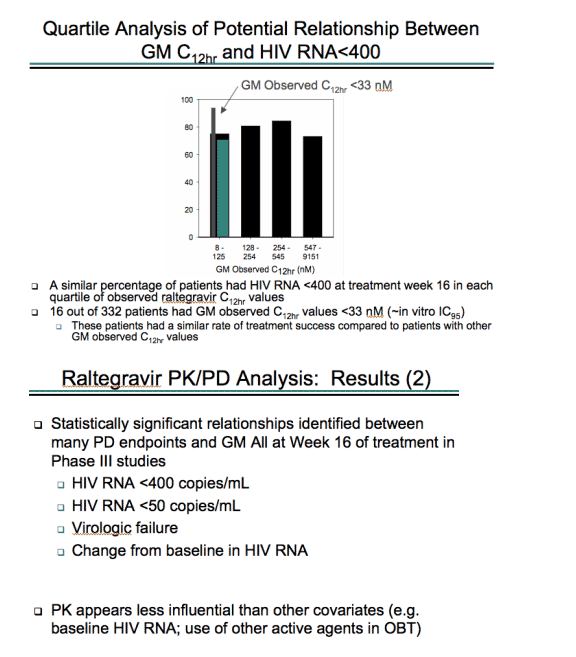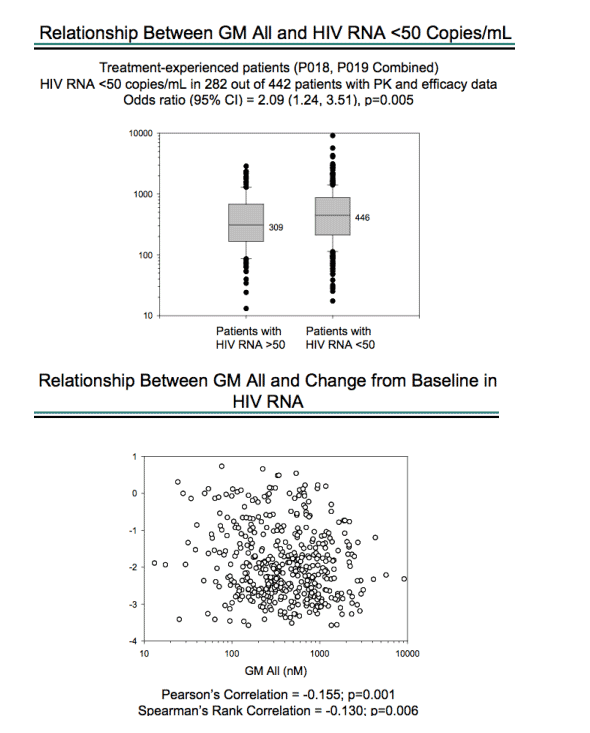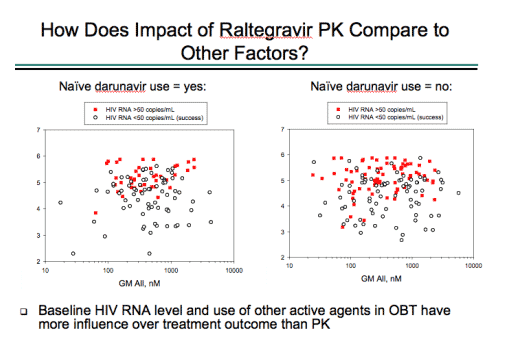 |
 |
 |
| |
Pharmacokinetic/Pharmacodynamic (PK/PD) analyses for Raltegravir (RAL) in phase II and III studies in treatment experienced HIV-infected patients
|
| |
| |
Reported by Jules Levin
L. Wenning, B.-Y. Nguyen, X. Sun, E. Hwang, Y. Chen, H. Teppler, C. Harvey, R. Rhodes, D. Ryan, N. Azrolan, J. Stone
9th International Workshop on Clinical Pharmacology of HIV
8-April-2008
ABSTRACT
Background: RAL is a novel HIV-1 integrase strand transfer inhibitor with potent in vitro activity against HIV-1 (mean IC95 = 31 nM in 50% human serum). PK/PD analyses were performed to examine potential relationships between RAL PK and viral response in treatment experienced patients.
Material & Methods: Plasma samples were collected during a Phase II dose-ranging study (RAL doses of 100, 200, 400, and 600 mg twice daily plus optimized background therapy (OBT)) and 2 Phase III studies (RAL dose of 400 mg twice daily plus OBT) during visits at Weeks 2 through 24 (1 sample per visit; 1 to 6 samples per patient). For each patient, the geometric mean (GM) of RAL concentrations for any samples collected between 11 and 13 hours postdose was calculated and reported as C12hr. Efficacy parameters HIV RNA <400, HIV RNA <50, virologic failure, and resistance mutations at amino acid 148 and/or 155 were estimated in all studies following 16 weeks of treatment and used for the PK/PD analyses. Data from all 3 studies were pooled for statistical analyses of potential relationships between RAL C12hr and efficacy outcomes using a logistic regression model. An odds ratio (95% CI) was determined, which represents the probability of the event occurring over not occurring for each 10-fold increase in C12hr.
Results: No statistically significant associations were obtained between RAL C12hr and any efficacy response. For the binary outcome of HIV RNA <400 or not, for example, the odds ratio (95% CI) was 0.84 (0.46, 1.55); p=0.582; N=332. Patients with the lowest C12hr values (below the in vitro IC95) had a similar probability of a successful treatment outcome compared to the rest of the study population.
Conclusion: No threshold RAL C12hr value was identified to be associated with reduced efficacy. Throughout the range of clinical experience from Phase II and Phase III studies in treatment experienced patients, all measured RAL plasma concentrations were associated with a similar high level of efficacy.
Raltegravir Background
HIV Integrase Strand Transfer Inhibitor
-- In vitro IC95 ~ 33 nM
Metabolism and excretion
-- Major mechanism of clearance is glucuronidation (UGT1A1)
-- Minor component of renal elimination
Raltegravir pharmacokinetics support BID dosing
-- Terminal t_ about 9 hrs with a shorter alpha-phase t_ about 1 hr
-- Slight degree of accumulation in C12hr with multiple doses
Pharmacokinetics similar across
--Gender, race, age (adults), HIV infection status, hepatic function, renal function, and body mass index
AUTHOR CONCLUSIONS
No statistically significant relationships identified between GM C12hr and any PD endpoint in Phase II or III studies (Week 16 of treatment)
Statistically significant relationships identified between many PD endpoints (Week 16 of treatment) and GM All
PK appears to have less influence on treatment outcome than other covariates (e.g. baseline HIV RNA; use of other active agents in OBT)
No threshold concentrations identified






|
| |
|
 |
 |
|
|